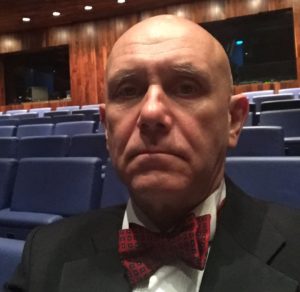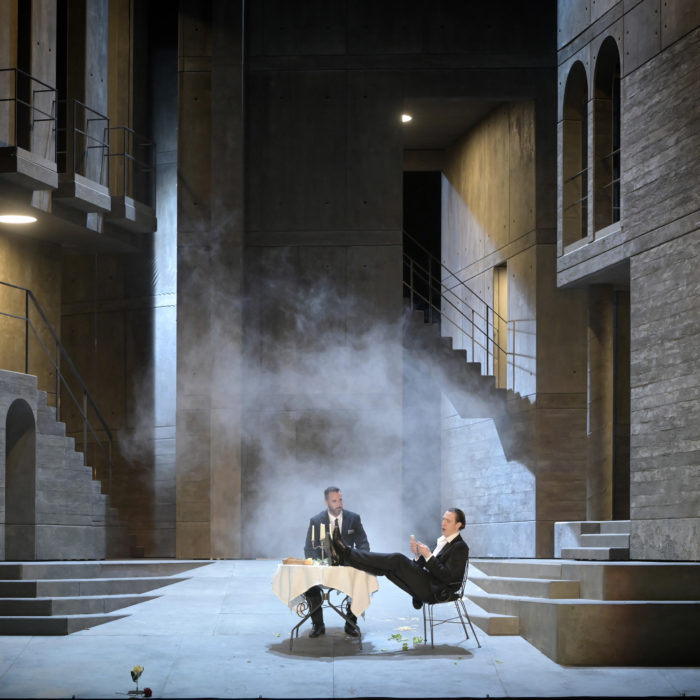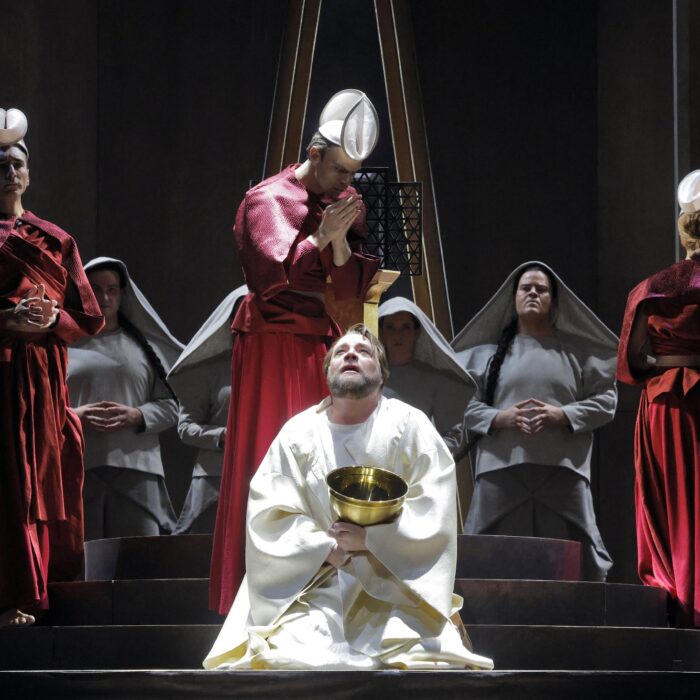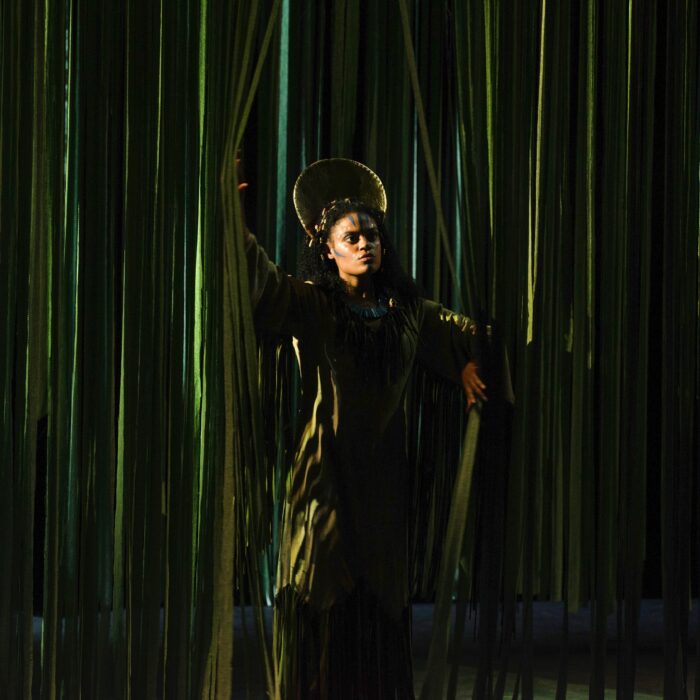
Dutch National Opera 2024 – 25 Review: Oum – A Son’s Quest For His Mother
El-Turk & Van Tongeren Combine To Create A Compelling Piece Of Theatre
By Alan Neilson(Photo: Bart Grietens)
What is an opera? Any attempt to construct a watertight definition is almost certain to fail and will likely lead to fruitless efforts to differentiate it from music theatre, musicals, oratorios and other forms of sung performances. Possibly, the best that can be hoped for is a loose definition that takes in its more obvious characteristics and accepts that there will always be grey areas in which opinion on specific works will be divided.
Each year, Dutch National Opera presents a series of contemporary operas as part of its Opera Forward Festival, with the aim of exploring new and experimental works, which will inevitably challenge traditional ideas about opera and draw attention to the problem of definition. Along with smaller events, three main operas were premiered, all of which confidently exhibited experimental elements that put them into the grey area, and in one case the piece went beyond even the most liberal of definitions and left one feeling mystified as to its inclusion.
First up was a work in a single act, lasting approximately 90 minutes, entitled “Oum – A Son’s Quest For His Mother,” written by the composer Bushra El-Turk, with music inspired by the singer Oum Kalthoum, to a libretto by Wout van Tongeren based on the novel “Visage retrouvé” by Wajdi Mouawad.
An Intense, Emotional Monologue
The narrative revolves around the character of Wahab, who as a child escaped a war raging in his homeland in the Middle East. Now a young man, and living in a city in the West, he finds himself troubled; he has no sense of his place in the world and has a difficult and complex relationship with his mother, who is dying in hospital. The drama is in the form of a highly emotional monologue in which he voices his pain and his inability to cry even though he knows he will never see his mother alive again. Only after her death is he able to confront his past and all its horrors, which eventually allows him to make a loving and heartfelt connection with his mother.
El-Turk’s score is written for a 12-piece ensemble comprising a mixture of Western and Middle Eastern instruments, comprised of violins, violas, a cello, a double bass, flutes and a ney (an end-blown flute), percussion, a qanûn (a stringed instrument similar to a zither), an ud (a fretless, stringed, pear-shaped instrument), and an accordion, recorders, a duduk, a kaval, a kamancheh (a bowed stringed instrument) and a ghaychak (bowed lute), which she used to create a vibrant, immediately accessible and recognisable sound that draws heavily upon the rhythms, textures and melodies of the Middle East and North Africa.
More specifically, her score paid homage to the famous Egyptian singer Oum Kalthoum, in which one of her most famous songs, “Al-Atial” (The Ruins), which laments a lost love, underpinned by a sense of resilience – although its imagery allows for a variety of interpretations – forms a motif that runs through the composition, sometimes appearing as obscure references, sometimes as clear fragments, and eventually is heard in full at the finale. The opera thus successfully brought together the subject of the libretto, that is, Wahab’s sense of alienation and his complex relationship with his mother, with the iconic song of Oum Kalthoum; the music and the text brilliantly connect to and support each other, drawing attention to the personal struggles experienced by many people of the Arab diaspora while highlighting the beauty, sensitivity and skill of one of the Arab world’s most acclaimed singers. The title of the work “Oum – a Son’s Quest For His Mother” is very revealing in that, while obviously referencing the singer, the word Oum actually means mother and thus relates the music to the text.
The director, Kenza Koutchoukali, created an aesthetically attractive staging, in which the musical ensemble was positioned on a raised platform across the back of the stage, with bold single colours lighting the backdrop, which were effective in capturing the intensity of Wahab’s emotional states. Props, positioned in the centre of the stage, were kept to a minimum, allowing the focus to remain firmly on Wahab, for whom Koutchoukali drew a magnificent performance from the actress Nadia Amin who played the character. Everything was centred on Wahab’s monologue. Three unnamed accompanying characters who played subservient roles remained for the most part in the background with only occasional forays into the centre of the stage. That was until the final scene when contralto Ghalia Benali stepped into the spotlight to bring the performance to a close with a stunning rendition of “Al-Atial.”
Costume designer Hannah Sibai highlighted the fragmented psychology of Wahab by clothing him in a simple grey tracksuit, which subtly distinguished him from someone born into a western society, but that also separated him from the three female characters in their colourful flowing costumes with strong non-western influences.
Amin’s essaying of the character of Wahab was superbly crafted to bring out his sense of pain, alienation and isolation. Such was the power and force of her portrayal that the fact that she was a female playing a male role had no consequence; it was an irrelevance! Her ability to charge the voice with emotional depth and honesty transcended any such considerations. She was ably supported by the musical ensemble, Amsterdam Andalusisch Orkest under the direction of Kanako Abe, who produced a sensitive, emotionally engaging accompaniment.
It also happened to be a spoken role.
Of the three singers, mezzosoprano Dima Orsho and soprano Bernadeta Astari had limited opportunities but made the most of them. Together with Benali, they created rich, attractive and alluring harmonies that added to the musical textures supporting Wahab’s emotions.
Benali’s brilliant rendition of “Al-Atial” proved to be an excellent way of bringing the work to a close. The energy, emotion and vocal magnetism that she was able to inject into her singing, coupled with mesmerising, slightly jerky choreographed movements, had the audience riveted, which demanded a reprise.
Excellent Theatre, But Is it an Opera?
The 90 minutes flew by! It was a great piece of theatre. But was it an opera? When the only named character, who also dominates the entire performance, is a spoken role, then the significance of the musical side of the work is inevitably reduced, especially when the spoken text is dense and extensive, as in this case. The relationship between words and music is changed; the pace of delivery along with the rhythmic and emotional connections between the music and the text are different, not necessarily for better or worse, but it is different and is thus a direct challenge to our common definitions of what an opera is.
Furthermore, the listener’s focus is drawn into the detail of the spoken word, and the music thus slides into the background. Of course, one could make a conscious decision to focus on the music and listen to its textural qualities and unusual instrumentation or engage with the work’s melodies and rhythmic variety, but that may result in large parts of the text being missed. Either way, the essential balance that an opera needs to achieve between them is lost.
El-Turk could have opted to set the text to music; operas in the form of monologues do exist, for example, Poulenc’s “La Voix Humaine.” Such a decision, however, would have significantly altered the nature of the work; either she would have had to alter the pace of the work by lengthening the piece or reducing the amount of text. Both solutions, of course, would have impacted (either positively or negatively) the dramatic quality of the work, and why would she want to make changes? After all, this is a quality theatrical work in its own right. Nevertheless, is it an opera?
One final point: by setting the English text to music, heavily indebted to Arabic forms, it would be necessary to alter the intonation and phrasing of the singers and risk sounding like a caricature, thereby fatally undermining the dramatic result and may even come across as disrespectful.
Personally, I would not class “Oum – A Son’s Quest For His Mother” as an opera but as a piece of music theatre. Many would disagree. Either way, it is an emotionally gripping and thought-provoking piece of drama.



